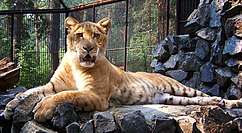Novosibirsk Zoo
The Novosibirsk Zoo (Russian: Новосибирский зоопарк) is a scientific institution as well as a popular tourist attraction. The zoo has around 11,000 animals representing 738 species and is an active participant in thirty-two different captive breeding programmes for endangered species. On average, over 1,500,000 people visit the zoo each year.[1]
 | |
| Location | Novosibirsk, Russia |
|---|---|
| Coordinates | 55.056°N 82.880°E |
| Website | www |
History
In 2000, the zoo was found to hold black-maned lions that appeared to be the closest surviving relatives of the extinct Cape lion of South Africa.[2][3] John Spence, a South African zoo director, had always been fascinated by stories of these grand lions scaling the walls of General van Riebeeck's castle in the 17th century. He believed some Cape lions might have been taken to Europe and interbred with other lions. His search took thirty years, which led him to the Novosibirsk Zoo, where he found the closest living resemblance to the Cape lion; the zoo called the lion Simon. The lion and his family are kept outdoors in large, natural settings. "It is kept all the year around in the climate conditions of the west Siberia at the temperatures from −49 to 36 °C [−56 to 97 °F]. In forty years, more than sixty cubs were born."[4] The Novosibirsk Zoo was able to send two lion cubs to Spence's zoo in South Africa for breeding.[3]
The zoo's director from 1969 until his death in 2016 was Rostislav Shilo. Simon's cubs were named after him and his wife, Olga.[5][6]
The zoo also received international attention upon the birth of Kiara, a rare liliger cub in November 2012. Her parents are a male lion and a female liger (male lion-female tiger hybrid).
Since 2016, the Center of oceanography and marine biology "Dolphinia" has been part of the zoo.[7]
Gallery
See also
Notes
References
- Official site. История зоопарка
- 'Extinct' lions (Cape lion) surface in Siberia. BBC News (2000-11-05). Retrieved on 2012-12-31 and 2015-03-30.
- Rebecca Davis (4 June 2012). "We lost a zoo: Western Cape's only zoo closes". Daily Maverick. Retrieved 2015-03-30.
- "Лев". Sibzoo.narod.ru. Archived from the original on March 29, 2009. Retrieved January 28, 2010.
- "Has Rare Lion of Africa's Cape Eluded Extinction?". National Geographic News. Retrieved January 28, 2010.
- Death of Rostislav Shilo, creator of one of world's finest zoos in Siberia
- О центре океанографии и морской биологии "Дельфиния" (in Russian). Novosibirsk Center of oceanography and marine biology "Dolphinia" official page. Retrieved 10 May 2020.

.jpg)
.jpg)




